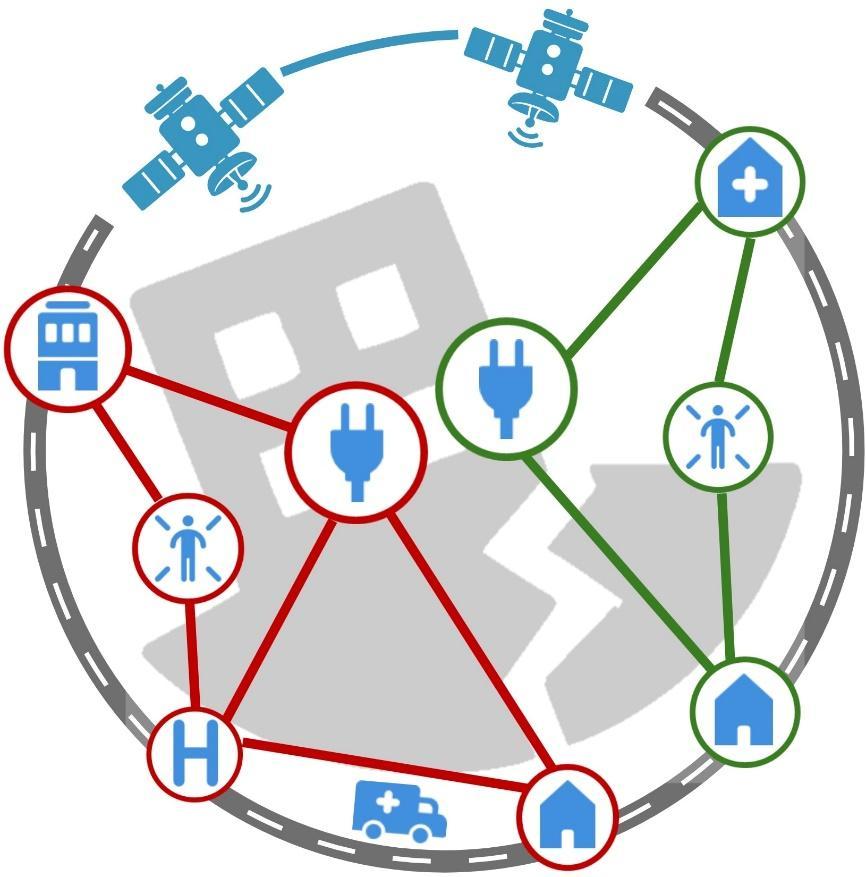
Smart cities are no longer just a futuristic dream; they are steadily becoming part of everyday life in the United States. From Columbus, Ohio’s electric vehicle charging infrastructure to Cary, North Carolina’s flood-detecting sensors, real-life examples show that technology is transforming how American cities operate. Still, challenges remain in funding, governance, and equity. This article takes a deep dive into how smart cities are evolving in the U.S., where progress is strongest, what obstacles remain, and what the future holds for Americans.
What Is a Smart City, and Why Does It Matter?
A smart city is more than just a city with high-speed WiFi or mobile apps. It is a holistic system where technology, data, and physical infrastructure work together to improve the quality of life for citizens.
At its core, a smart city integrates several components:
- IoT (Internet of Things) devices that gather real-time information, such as traffic flows, air quality, or energy use.
- Advanced connectivity infrastructure, such as 5G networks, public WiFi, and fiber broadband.
- Sustainable energy and water management, helping cities cut costs and emissions.
- Smart mobility systems, including EV charging stations, shared bikes and scooters, and even autonomous shuttle experiments.
- Citizen engagement platforms, giving residents a voice and making government services more accessible.
Why does this matter? Because U.S. cities face enormous challenges: traffic congestion, aging infrastructure, climate change impacts, public safety, and inequality. Smart cities aim to address these challenges through innovation, efficiency, and inclusivity.
Are Smart Cities Already in the U.S.? Real-Life Examples
Yes, smart cities are not just concepts—they are happening. While progress varies across states and cities, several U.S. municipalities are pioneering projects that demonstrate what a smart city looks like in practice.
Columbus, Ohio (Smart Columbus)
Columbus won a $40 million U.S. Department of Transportation grant to transform mobility. The project created “mobility hubs” combining bike share, scooter share, EV charging, and public transit options. The city also rolled out over 900 EV charging stations and piloted autonomous shuttle services. While some experiments faced pushback, Columbus shows how public-private partnerships can accelerate change.
Cary, North Carolina
Cary has deployed smart trash bins that signal when they need emptying, IoT-enabled flood sensors to warn of rising water, and smart traffic lights that optimize signal timing for emergency vehicles. These practical tools improve safety and efficiency without overwhelming citizens with unnecessary technology.
Peachtree Corners, Georgia
This Atlanta suburb has developed “Curiosity Lab,” a 500-acre living laboratory for autonomous vehicles, 5G connectivity, and other emerging technologies. It is not just a showcase but a proving ground where startups, universities, and companies test innovations in real environments.
Dallas, Texas
Dallas is working toward a 2030 “Smart Dallas” vision. Projects include LED street lighting, citywide WiFi pilots, and environmental monitoring. As one of the largest U.S. metros, Dallas illustrates both the opportunities and the complexities of scaling smart city initiatives across a diverse and growing population.
New York City
America’s largest city has established a Smart City Testbed program where technologies like AI traffic management, renewable energy integration, and sustainability dashboards are tested before scaling. With vast resources but complicated governance, New York represents both the promise and the challenge of smart cities.
How Widespread Is Smart City Adoption in the U.S.?
Recent data shows a rapid increase in smart city adoption:
- Over 60% of U.S. urban leaders report that real-time IoT data now informs daily city operations.
- The U.S. smart city market was valued at $43.7 billion in 2020 and is expected to exceed $120 billion by 2025.
- Rankings place cities like Atlanta, San Francisco, Boston, and Chicago among the most prepared for smart futures due to their tech ecosystems, sustainability goals, and strong labor markets.
But adoption is uneven. While tech-forward metros are racing ahead, smaller cities often face financial and regulatory roadblocks.
What Technologies Are Driving Smart Cities?
Americans searching about smart cities often ask: What tech is actually being used? Here are the most common systems shaping smart city projects:
- IoT sensors for traffic, air quality, noise, and waste management.
- Smart traffic lights that adapt in real time to reduce congestion.
- EV charging infrastructure supporting the electric mobility transition.
- Autonomous vehicles and shuttles, still in pilot stages.
- Smart grids and microgrids integrating renewable energy with storage.
- Digital public service apps showing real-time bus arrivals, city alerts, or energy dashboards.
These tools are no longer experimental—they’re active in dozens of American cities.
The Biggest Hurdles to Becoming Truly “Smart”
If smart cities sound so promising, why isn’t every city already smart? There are five core challenges:
- Funding – Smart tech requires major upfront investments and ongoing maintenance. Grants help, but not all cities have the resources.
- Regulation and governance – Data privacy, procurement rules, and fragmented oversight make implementation difficult.
- Interoperability – Proprietary systems from different vendors don’t always connect, creating “islands” of data.
- Public trust and equity – Without transparent communication, citizens fear surveillance or exclusion.
- Legacy infrastructure – Retrofitting 100-year-old roads, water systems, or power grids is costly and slow.
These obstacles explain why many cities start with pilot projects rather than immediate citywide rollouts.
How Smart Cities Improve Daily Life
Smart city technologies are not abstract; they affect real problems Americans face every day:
- Less traffic frustration: Adaptive traffic lights reduce congestion and shorten commutes.
- Cleaner neighborhoods: Smart trash bins prevent overflow and improve sanitation.
- Fewer outages: Smart grids detect problems in energy distribution before blackouts occur.
- Better air quality: Sensors track pollution in real time, guiding policy and citizen choices.
- More equitable transit: Mobility hubs expand affordable, multimodal transport.
- Faster emergency response: IoT-enabled traffic lights prioritize ambulances and fire trucks.
These examples show how technology quietly improves city life.
Where Does the U.S. Stand Globally?
Compared to global leaders, the U.S. is competitive in tech infrastructure and innovation. But European cities like Barcelona or Asian leaders like Singapore often outperform in integrated planning, sustainability, and universal digital access.
U.S. cities face unique challenges: fragmented government systems, high political polarization, and stark inequality. Yet America’s innovation ecosystem, strong private sector, and culture of experimentation ensure that it remains a major smart city player.
Near-Future Trends: What’s Next for U.S. Smart Cities?
The next 5–10 years will likely bring:
- Expansion of EV charging stations across all states.
- Greater adoption of AI for predictive analytics—from pothole detection to traffic optimization.
- Neighborhood microgrids providing renewable energy resilience.
- Widespread use of digital twins, virtual replicas of cities used to model traffic, climate impacts, or infrastructure upgrades.
- Stronger focus on climate resilience—flood sensors, heat mitigation, and green infrastructure.
- Increased citizen engagement through apps, dashboards, and open data portals.
These trends will make smart cities more visible in daily American life.

FAQs: The Questions Americans Are Asking About Smart Cities
1. What makes a city truly “smart”?
A smart city integrates digital technologies, IoT sensors, and data analytics to enhance urban living. It prioritizes sustainability, efficiency, and inclusivity. Beyond offering digital services, a truly smart city reimagines transportation, energy, public safety, and citizen engagement, creating a more connected, resilient, and livable environment for all residents.
2. Will my city adopt smart tech soon?
Most medium and large U.S. cities are actively deploying smart technologies through federal funding, innovation challenges, and private sector partnerships. While smaller towns may progress slower due to budget constraints, the overall national trend strongly points toward wider adoption of smart solutions in transportation, utilities, and public services.
3. Do smart cities cost taxpayers more?
Smart city projects often require significant upfront investments in infrastructure, sensors, and digital platforms. However, long-term savings usually outweigh costs by lowering energy consumption, reducing traffic congestion, and optimizing public services. The ultimate goal is financial efficiency, environmental sustainability, and improved quality of life for taxpayers and residents.
4. What smart city features might I see in my daily routine?
Daily life in a smart city often includes adaptive traffic signals that reduce waiting times, real-time transit apps showing bus or train arrivals, smart parking systems, and free downtown WiFi. Energy-efficient streetlights, smart waste collection bins, and connected emergency response systems are also becoming increasingly common features.
5. Are there privacy risks?
Yes, privacy concerns are a significant challenge. Smart cities use cameras, connected sensors, and vast data collection to optimize services. Without strict policies, risks of misuse or breaches increase. Transparent governance, robust cybersecurity, clear consent policies, and active public participation are essential safeguards to build citizen trust and security.
6. Do smart cities help fight climate change?
Smart cities directly contribute to sustainability by reducing greenhouse gas emissions, lowering energy use, and managing resources more effectively. Technologies like electric buses, smart grids, renewable-powered microgrids, and intelligent water systems help conserve natural resources while promoting eco-friendly practices, positioning smart cities as critical allies in climate resilience.
7. Will AI replace humans in city management?
AI will not replace human city managers but instead complement them. It supports decision-making with predictive analytics, traffic modeling, and emergency forecasting. Policymakers, urban planners, and first responders remain essential for ethical, empathetic, and nuanced governance. AI acts as a powerful tool, not a complete replacement for humans.
8. What about rural areas?
Rural communities are beginning to experiment with “smart village” concepts, including connected healthcare, precision agriculture, and community-wide broadband. Federal rural broadband initiatives are vital for bridging digital divides. However, limited budgets, lower population densities, and fewer partnerships often make progress slower compared to larger metropolitan smart city projects.
9. How do smart cities handle old infrastructure?
Most smart cities retrofit existing infrastructure with IoT sensors, smart meters, and digital monitoring systems. Instead of replacing entire systems, phased upgrades allow gradual transformation. Tools like digital twins create virtual models of buildings and utilities, enabling planners to test improvements, optimize resources, and reduce costs during modernization efforts.
10. Have some smart city projects failed?
Yes, several smart city pilots in the U.S. and globally have failed. Common reasons include underfunding, lack of public trust, weak interoperability between systems, or insufficient community engagement. These lessons now inform better planning, emphasizing citizen participation, scalable designs, and transparent governance to ensure long-term project sustainability and success.
11. Do smart cities create or eliminate jobs?
Smart cities create new employment opportunities in technology, data science, engineering, and systems maintenance. At the same time, automation may reduce demand for traditional roles in transportation, utilities, or administrative services. The solution lies in workforce reskilling, preparing workers to transition into emerging digital economy jobs and industries.
Practical Takeaways for Leaders and Citizens
- For city leaders: Plan for long-term maintenance, not just flashy pilots. Use open standards and build equity into every project.
- For citizens: Demand transparency and involvement. Ask how data is collected and used. Advocate for projects that benefit all neighborhoods.
- For businesses and innovators: Build solutions that are scalable, inclusive, and transparent. Cities don’t want “vendor lock-in.”
Conclusion
So—are smart cities becoming a reality in the United States?
Yes, they are. From large metros like New York to small communities like Cary, smart technologies are no longer hypothetical. Americans are already seeing the benefits in cleaner air, faster commutes, smarter energy, and better connectivity.
